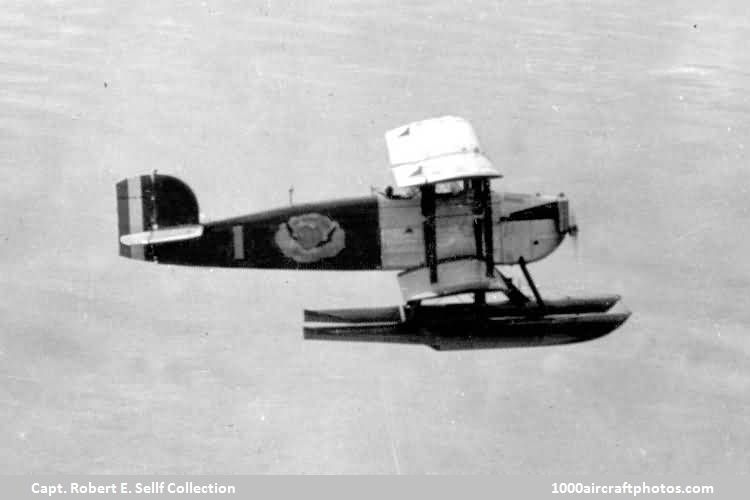06/30/2009. Parts of the 'Seattle' have been recovered and are now in display in a museum in Alaska. At least one part is in Seattle. There is also a group building a replica of the 'Seattle' in the Seattle, Washinton area. All of the 'Boston II' has been lost except for one part. Some of the original wing material of the 'Chicago' was cut into squares, attached to an image of the plane and sold by the Smithsonian in the early 1970s.
11/30/2006. Remarks by Jack McKillop: "This was No. 1 of the four DWCs (Douglas World Cruiser) that took off from Sand Point Airport, Seattle, at 0847 hours local on April 6, 1924 on an around-the-world flight from east-to-west.
The pilot of this aircraft was Major Frederick L. Martin, commanding officer of the Technical School at Chanute Field, Rantoul, Illinois, USA; all of the aircraft had a mechanic on board, Staff Sgt Alva L. Harvy joined Major Martin. The other three DWCs and their crew were: No. 2 (23-1230 c/n 146) 'Chicago' (Lt Lowell Smith, Lt Leslie Arnold); No. 3 (23-1231 c/n 147) 'Boston' (Lt Leigh Wade, Staff Sgt Henry H. Ogden); and No. 4 (23-1232 c/n 148) 'New Orleans' (lt Erik Nelson, Lt John Harding).
Their first stop was at Prince Rupert, British Columbia, Canada, and they landed there after 8 hr 15 min of flying. Major Martin landed the aircraft in shallow water and damaged the left pontoon and wing strut but the plane was ready to fly the next morning.
The next day, the four aircraft departed for Sitka, Territory of Alaska, USA, where they remained for three days due to weather. Their next stop was Seward and then they were to fly to Chignik, located on the east coast of the Alaska Peninsula at the head of Anchorage Bay. En route to Chignik, 'Seattle' developed engine problems and Martin was forced to land in a sheltered bay; he and his mechanic spent the night in the aircraft. The other three aircraft proceeded to Chignik and sent a message to the US Navy alerting them that Martin was down. The Navy dispatched two destroyers and they found 'Seattle' the next morning. The destroyers towed the aircraft to Chignik for repairs and Martin sent a message to the other six men to continue to Dutch Harbor on Unalaska Island, Aleutian Islands.
Martin's plane was finally repaired and he took off from Chignik at 0400 hours. Instead of following the coastline, Martin took a shortcut across the Alaskan Peninsula but encountered bad weather. As he flew down a valley, the ground rose and he had to climb higher and higher until he eventually flew into the clouds and encountered zero visibility. His pontoon grazed a hilltop and the plane crashed and was destroyed. Martin and his mechanic spent two days waiting to be rescued and then struck out on foot finally arriving at the small fishing village of Port Moeller ten days after crashing.
The remaining three aircraft continued the flight down the Aleutian chain and then to the Soviet Union, Japan, China, Hong Kong, French Indochina, Siam (now Thailand), Burma, India, Persia, Iraq, Syria, Turkey, Rumania, Hungary, Austria, France and the United Kingdom. While en route from Scapa Flow (Kirkwall), Scotland, to Iceland on August 3rd, 'Boston' had engine trouble and was forced to land at sea. The two airmen were rescued by the US Navy light cruiser USS Richmond (CL-9) which then began towing the DWC to the Faeroe Islands however, the sea got rougher and 'Boston' was cut loose and it sank moments later.
The two remaining aircraft, 'Chicago' and 'New Orleans', had arrived in Iceland safely and they would continue the flight to Greenland, Labrador and Nova Scotia, Canada. When they arrived at Pictou, Nova Scotia, they found the prototype DWC, now renamed 'Boston II', prepared to continue the flight back to the USA. Weather forced the three aircraft to make a landing at Casco Bay, Maine, before flying on to Boston, Massachusetts, Mitchell Field, New York and Bolling Field, Washington, District of Columbia, USA. From there it was across the USA stopping in 14 cities in nine states and finally arriving back in Seattle at 1330 hours local on September 28, 1924. The two remaining original aircraft had flown 371 hr and 11 min of flying time in 175 days and covered 27,553 mls (44,342 km).
Currently, 'Chicago' is on display at the National Air and Space Museum in Washington, 'New Orleans' is owned by the Natural History Museum of Los Angeles County, California, USA, and was on loan to the Museum of Flying located at the Santa Monica Municipal Airport, California."
(NOTE: By early June 2009 the Museum had been closed for over two years, and it is uncertain if and when it will reopen.)
